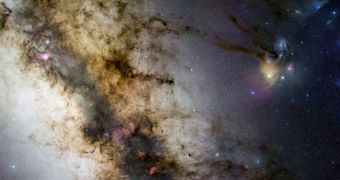Scientists from the European Southern Observatory's (ESO) Very Large Telescope (VLT) have recently revealed the second image of the Milky Way, taken as part of the ongoing GigaGalaxy Zoom project. The first image was released less than a week ago, as we were telling you at the time. While the last photo was an interactive map of the entire night sky, as viewed by amateur astronomers, the recent 34 by 20-degree wide view deals only with our galaxy's core. Like the one before it, it was taken by renowned astrophotographer Stephane Guisard, who is also an ESO engineer.
The photograph was taken from the Cerro Paranal site, in the Atacama desert of northern Chile, where the VLT and the VLT Survey Telescope are located. It took 29 nights for Guisard to collect the over 1,200 photographs he needed to compile the new map. More than 200 hours of exposure were needed for the true-color, high-quality images to be obtained, an official press release on ESO's website shows. Because the expert is an optical engineer specializing in telescopes, he was the natural choice for leading the GigaGalaxy Zoom, as he is one of the few astrophotographers with such training in the world today.
The new image shows the area of the sky between the constellations of Sagittarius (the Archer) and Scorpius (the Scorpion), and features the dusty lane of the Milky Way running on the diagonal. Features such as the Rho Ophiuchi and Antares regions, as well as the Pipe and Snake nebulae are also visible for amateur and professional astronomers alike. “The area I have depicted in this image is an incredibly rich region of the sky, and the one I find most beautiful,” Guisard says. At the center of the galactic core, there is the area where the supermassive black hole that keeps our galaxy together resides.
“This gorgeous starscape is the second of three extremely high resolution images featured in the GigaGalaxy Zoom project, launched by ESO as part of the International Year of Astronomy 2009 (IYA2009). The project allows stargazers to explore and experience the Universe as it is seen with the unaided eye from the darkest and best viewing locations in the world. GigaGalaxy Zoom features a web tool that allows users to take a breathtaking dive into our Milky Way. With this tool users can learn more about many different and exciting objects in the image, such as multicolored nebulae and exploding stars, just by clicking on them,” the press release reads.

 14 DAY TRIAL //
14 DAY TRIAL //